CGC Census - Exploring Second Issues - Is it ever better to be second?
Continuing the exploration of the CGC Census, this month the focus is second issues. Most titles see a significant decrease in both the value and the number of CGC submissions for issue #2 when compared to issue #1.
There are 232,766 different comic books graded by CGC on the CGC Census (April 19, 2022). There are 50,048 different comic books graded by CGC are a #1 issue (21.5%). The total number of submissions on the CGC Census is 7,444,146, with 2,159,016 as #1 issues (29%). For #2 issues, 14,592 different comic books have been graded by CGC (6.3%). The total number of submissions on the CGC Census for #2 issues is 318,492 (4.3%).
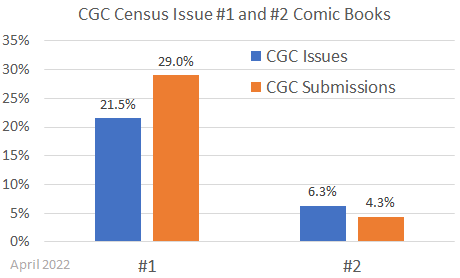
20,652 of the 50,048 different #1 issues have at least ten CGC submissions (41.3%).
10,843 of the 50,048 different #1 issues were published in 1999 or earlier (21.7%).
The combination of at least ten CGC submissions and a date of 1999 or earlier results in only 4,118 different #1 issues (8.2%). Those 8.2% of #1 issues total 811,414 CGC submissions (10.9%).
4,080 of the 14,592 different #2 issues have at least ten CGC submissions (28%).
5,150 of the 14,592 different #2 issues were published in 1999 or earlier (21.7%).
The combination of at least ten CGC submissions and a date of 1999 or earlier results in only 1,610 different #2 issues (11%). Those 11% of #2 issues total 147,400 CGC submissions (2%).
The year 1999 was chosen for two reasons. First, 1999 is prior to the start of CGC grading. Second, a significant increase in the number of comics produced with #1 on the cover has occurred since 1999. This increase corresponds with the increase in the number of variants produced by publishers. First issues of comics with dozens of variants are separated issues in the CGC Census, with each having #1 on the cover.
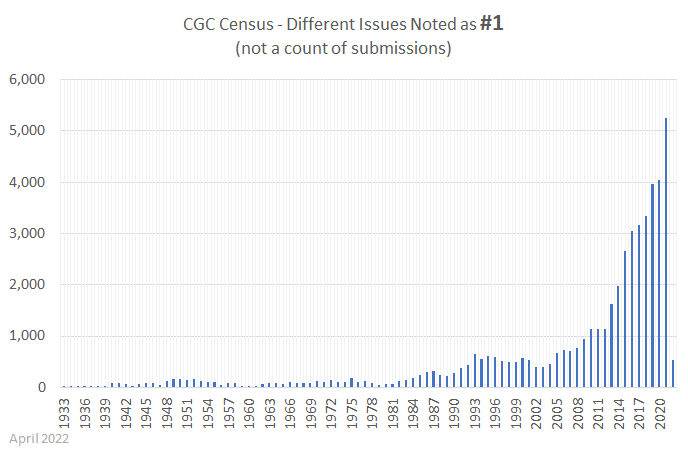
1,546 different #1 issues with at least ten CGC submissions from 1999 or earlier do not have a corresponding #2 issue in the CGC Census. These #1 issues without a corresponding #2 may represent titles which were one-shot (only one issue was published), alternate covers which were only created for #1 issues (gold, platinum, special edition), or relatively unpopular titles where the second issue has not been submitted to CGC at all. The #2 issue must have the same year or one year later than the #1 issue, to ensure it is the second issue in a series, rather than a much later continuation or a reprint of issue #1.
2,594 different #1 issues with at least ten CGC submissions from 1999 or earlier have at least one CGC submission for issue #2 in the title. This creates 2,594 one-two (#1-#2) combinations for analysis.
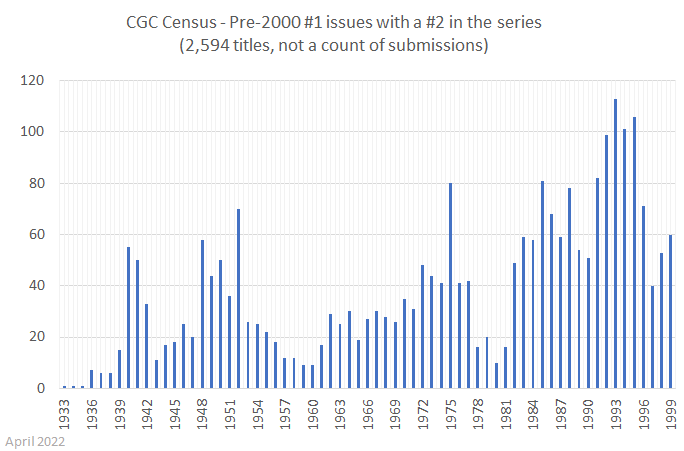
For these 2,594 one-two combos, the number of CGC submissions is higher for issue #1 than issue #2 in 2,485 combos (95.8%). This 95.8% rate of #1 submission majority would be higher if the number of titles with an existing issue #2, but no CGC submissions, was known. Regardless, it is very unusual when the #2 issue in a series has more CGC submissions than issue #1, occurring only 109 times.
For the 109 one-two combos where issue #2 has more CGC submissions than issue #1, there are 18 which occur in the years 1951 and 1952. These 1951-1952 titles include Crime Mysteries, Crusader from Mars, Journey Into Fear, Mister Mystery, Prison Break, Silly Symphonies, Space Adventures, Space Busters, Space Detective, Tales of Terror Annual, Teen-Age Temptations, This Magazine is Haunted, Two-Fisted Annual, Weird Mysteries, Weird Tales of the Future, Weird Terror, White Princess of the Jungle, and Witches Tales.
The most valuable comic book included in these 109 one-two combos is Superman #1 (1939) which has 167 CGC copies on the current CGC Census, over 25% lower than Superman #2 with 227 CGC submissions. In contrast, Acton Comics #1 (1938) has 75 CGC copies while Action Comics #2 (1938) only has 43 graded copies.
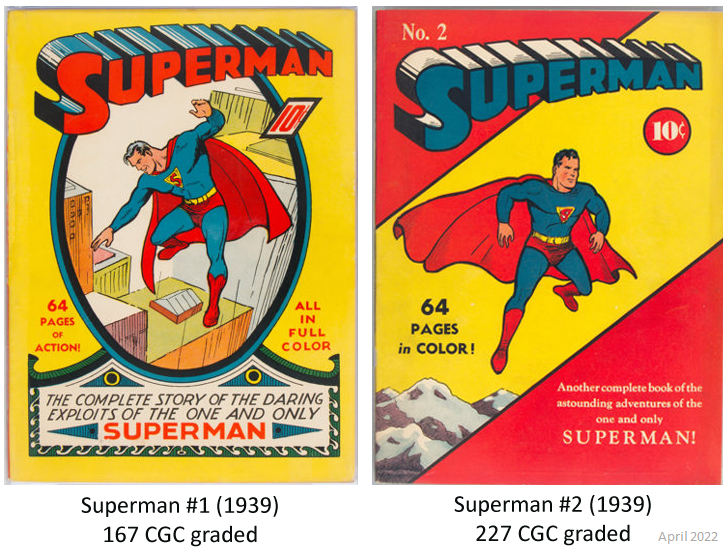
The highest number of CGC submissions in the 109 one-two combos is 6,231 for New Teen Titans #2 (1980), compared to 2,403 for issue #1. X-Force #2 (1991) is second highest with 4,593 CGC submissions compared to 2,471 for issue #1.
The greatest percentage increase of CGC submissions in the 109 one-two combos is +2,867% for San Diego Comic Con Comics #2 (1993), with 979 submissions versus only 33 for San Diego Comic Con Comics #1 (1992). For more traditional modern series (and originally available outside of San Diego), Primer #2 (1982) is +2,428% at 733 submissions versus 29 for Primer #1.
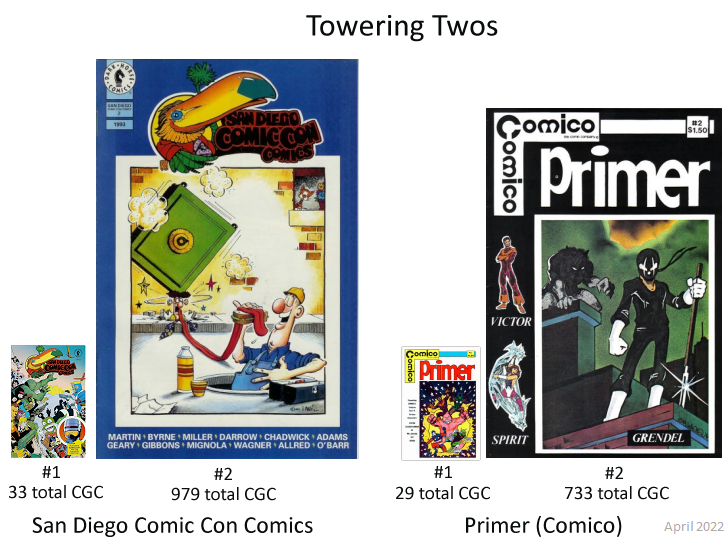
Other independent publisher comics from the 1980s in the 109 one-two combos with issue #2 CGC submissions exceeding issue #1 are Albedo #2, Alien Worlds #2, Starslayer #2, Teenage Mutant Ninja Turtles #2, and Vanguard Illustrated #2. Dave Stevens artwork is featured for issue #2 (but not issue #1) of Alien Worlds, Starslayer, and Vanguard Illustrated. Besides artwork preferences, the most common reason for modern age issue #2 to exceed the number of submissions of issue #1 is the first appearance of a new (or more popular) characters in issue #2.
There is only one issue #2 of any title with more CGC submissions than New Teen Titans #2, and that is Wolverine Limited Series #2 (1982) with 6,480. While that total is highest for all CGC graded issue #2 comics, Wolverine Limited Series #1 (1982) is significantly higher with 20,734 CGC submissions.
More in-depth analysis would be needed to determine how often issue #2 has a higher value than issue #1. Known examples of higher issue #2 value from titles mentioned in this article are Albedo #2, New Teen Titans #2, Primer #2, San Diego Comic Con Comics #2, Starslayer #2, Vanguard Illustrated #2, and X-Force #2, but the GPAnalysis recorded sales averages are not remotely comparable for Superman #2 or Teenage Mutant Ninja Turtles #2, compared to the #1 issues in the same CGC condition.
About the Author
 |
Greg Holland has collected comic books for over 30 years and has been the administrator of the CGC Census Analysis website since 2003, currently located at CGCdata.com. He is the 1999 founder of the ValiantComics.com website and the 2004 ValiantFans.com message board. Dr. Holland holds a Ph.D. in information quality from the University of Arkansas at Little Rock and has held data science positions as research director, analyst, and administrator for government, corporations, and university. Active on the CGC Forums as ‘valiantman’ since 2002, he is also a 15+ year advisor to the Overstreet Comic Book Price Guide and contributor to later editions of the Standard Catalog of Comic Books. Greg resides in Arkansas, USA, with his wife and their daughter. |
Related news
24 Oct 2022
Canadian Price Variants (CPVs) and GPAnalysis.com Recorded Sales
With Canadian Price Variants recorded in GPAnalysis.com for decades, what can the data tell us about rarity and value when comparing against direct editions?
Read more26 May 2022
CGC Census - A Game for the Thousandth Collector
Imagine a game where 1,000 lucky comic collectors are awarded the best available copies of comic books from the CGC Census. Where would ticket #1,000 be for the earliest appearances of favorite characters? Some winning books may surprise you.
Read more